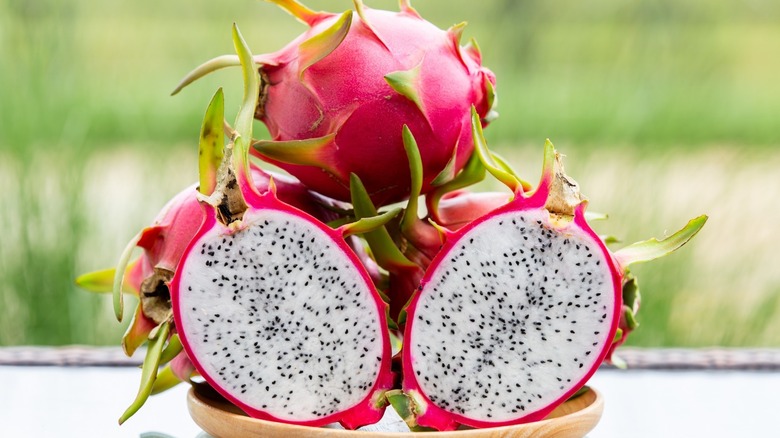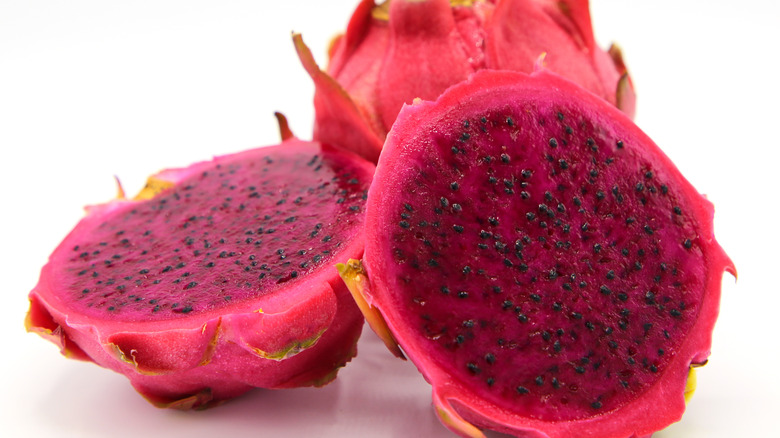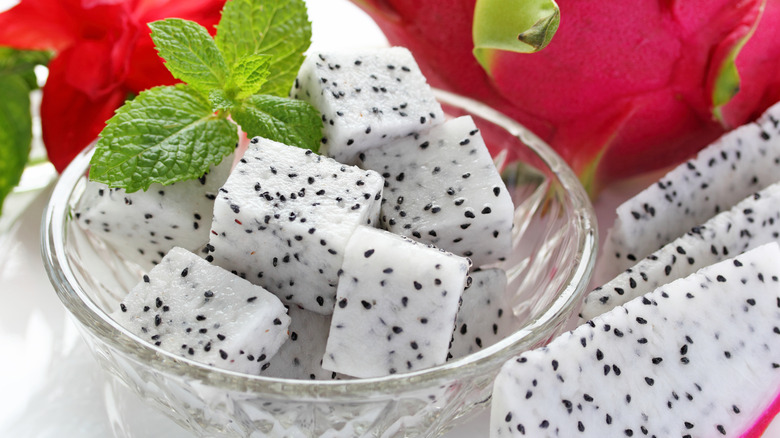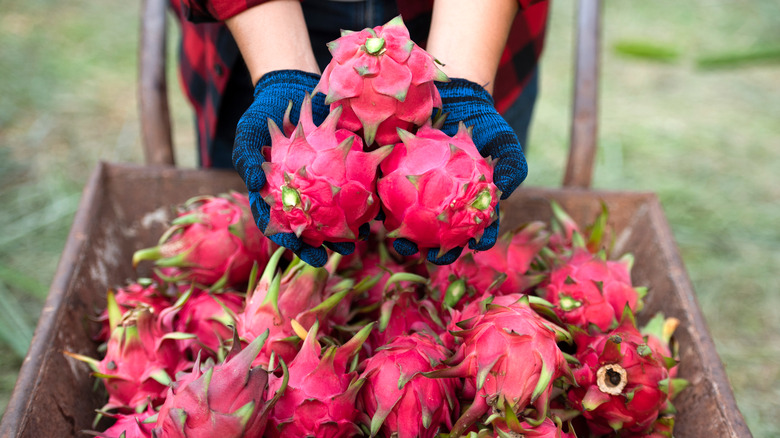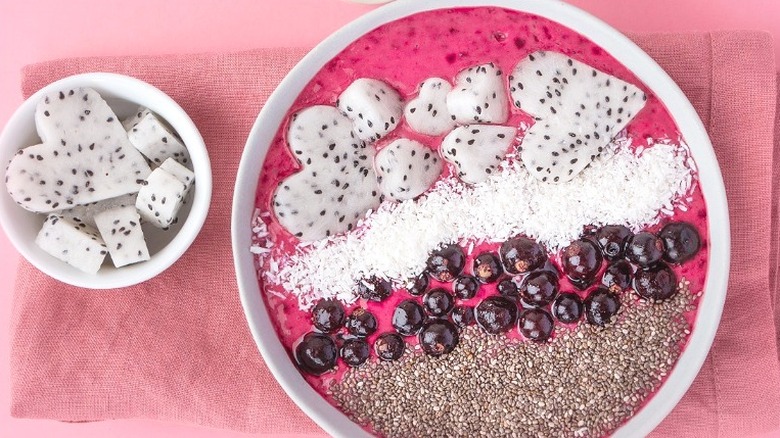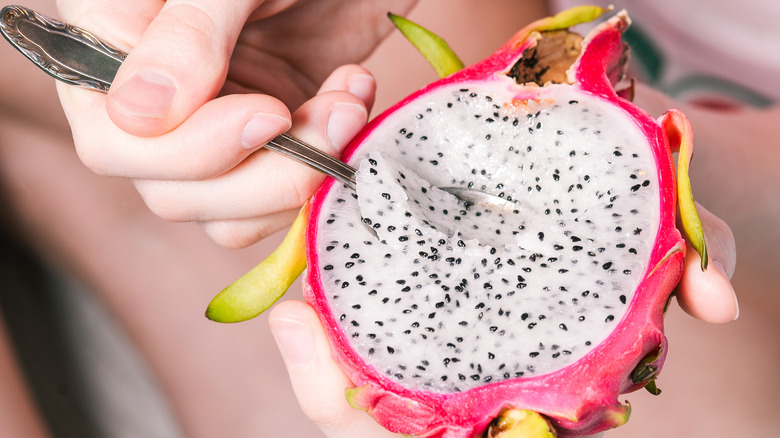Everything You Need To Know About Dragon Fruit
There's no doubt that dragon fruit will catch your eye when you see it on display at the grocery store or sliced up in a smoothie bowl. It can look a little intimidating if you've never tried one before, but don't let that stop you! This fruit is stunning inside and out, and a delicious and unique addition to recipes or to eat fresh.
According to The Spruce Eats, dragon fruit are oval-shaped with tough outer skins. They're covered with green leaves that give them a spiky, scaly look, hence the "dragon" moniker. They're strikingly beautiful with a pink or yellow outer skin that contrasts dramatically with the green spikes. Depending on the variety, the flesh inside can be white, red, purple or pink, and all are studded with tiny black seeds. Dragon fruit also goes by the names pitaya or strawberry pear. The fruits are the product of a cactus in the Hylocereus family. According to Gardenia, the plant grows as a large, clinging vine with jointed stems that can be up to 20 feet long. The vine produces oversized, beautiful white flowers that are nocturnal, highly fragrant, and only open for a single night. It's from these pollinated flowers that dragon fruit grow.
Varieties of dragon fruit
Though you may only ever see one kind of dragon fruit available in your store, there are actually a few varieties out there. The color of both the skin and the flesh inside will help you identify which variety you have. According to The Spruce Eats, the most common type of dragon fruit sold in stores is Hylocereus undatus, which has a bright pink exterior and white flesh. Varietals of this dragon fruit also have some pretty far-out names that you might see them sold under, like David Bowie, Cosmic Charlie, and Seoul Kitchen. The Spruce Eats also shares that this is the least sweet type of dragon fruit.
Another dragon fruit is the Hylocereus polyrhizus, which has pink outer skin and pinkish-red flesh. This type is usually larger and sweeter. Names this dragon fruit are sold under include Bloody Mary and Voodoo Child. Hylocereus guatemalensis is a dragon fruit with a lighter pink rind. The flesh inside is a stunning shade of purplish-red, which is likely why it can be seen for sale under the name American Beauty.
The sweetest dragon fruit variety is the smaller Selenicereus megalanthus. The outer rind is bright yellow, with a knobby look thanks to stubbier leaf nodes over the surface. The fruit inside is bright white with black seeds. Melissa's describes the taste as "a rush of sweetness mixed with floral juice." Unfortunately, this variety tends to be more difficult to find.
What does dragon fruit taste like?
After finding out what it is, the next question most people have about dragon fruit is "What does it taste like?" Understandably so, since there's little about the outside of the fruit to give us any clues! When you slice open a dragon fruit the first thing you'll notice are the hundreds of tiny black seeds suspended in the flesh. For this reason, according to Parade, dragon fruit's texture is usually compared to that of kiwi fruit, which is also loaded with tiny seeds. A bite of dragon fruit will have that same combination of juiciness and crunch as a slice of kiwi has.
As for the fruit's flavor, The Spruce Eats shares that it's often described as "tropical," which makes it a natural pairing with other warm climate fruit like mango and pineapple. The flesh is also described as tasting similar to that of pear, watermelon, or the mild flavor of kiwi. The size of the seeds inside and the level of sweetness will depend on the variety of dragon fruit you choose.
Where to find dragon fruit
Serious Eats shares that dragon fruit thrive in hot, tropical climates, and are native to several countries throughout Central and South America. Today the fruits are also grown in parts of Southeast Asia, including Vietnam. According to Garden.eco, dragon fruit are grown commercially in the U.S. in Florida, Hawaii, and California, though many of the dragon fruit in stores are still imported from other countries, which is why it can be expensive.
To buy dragon fruit, The Spruce Eats recommends looking for it in well-stocked supermarkets that have a good selection of tropical fruits, or in Asian markets or specialty shops. According to Women's Health, stores may also carry dragon fruit peeled and frozen in the same freezer case where other frozen fruits are sold. In the states where the climate is hot enough to grow dragon fruit commercially, you may have luck finding the fruit at local produce vendors. The peak of the season lasts from summer through to early fall.
When shopping, choose dragon fruit that gives just a little when you press on its surface. Avoid those with shriveling, brown spots, or fruits that seem very soft. Once home, you can keep ripe dragon fruit on the counter at room temperature for a few days. For longer storage, The Spruce Eats suggests keeping them in a plastic bag in the fridge.
How to use dragon fruit
Dragon fruit's texture makes it fun and versatile to use in all kinds of dishes. According to The Spruce Eats, removing the flesh from inside the fruit is a process similar to that of avocados — except without the massive pit. First, slice a dragon fruit in half. Then insert a spoon between the flesh and the inside of the rind, and run the spoon all the way around, which removes the insides all in one piece. You can then slice it into cubes, slivers, or other shapes and it's ready to serve. Other options are to use a melon baller to scoop out perfect spheres, or to slice the fruit into wedges with the rind still attached, like you would with an orange. Parade notes that the rind is not edible, so only consume the flesh inside.
Dragon fruit is delicious fresh, especially in fruit salads, and it makes a beautiful addition to smoothie bowls. The Spruce Eats says it's also very good with fish, either as a side dish or chopped into salsa. Blend dragon fruit to make exciting drinks, like Starbucks does with their Mango Dragon Fruit Refresher, or try Parade's recipe for a Dragon Fruit shrub, which can be enjoyed as-is or used as a delicious cocktail mixer. Clean Eating likes dragon fruit diced into a frisée salad, served alongside lemon chicken and butternut purée.
The nutritional value of dragon fruit
Not only is dragon fruit beautiful to look and delicious to eat, it has impressive nutritional benefits as well. According to Nutritionix, one dragon fruit has only 61 calories, and yet that small fruit also packs 3 grams of filling fiber — that's 12% of the recommended daily allowance. That's not all — one serving of dragon fruit has 154% of the recommended daily intake of vitamin C, plus small amounts of iron, vitamin A, and calcium. The fruit also has 312 milligrams of potassium, which 9% of the recommended daily amount.
Food Network shares that the seeds in dragon fruit contain a small amount of fats that are known to support heart health. In addition, the fruit has the antioxidants lycopene and phytoalbumin. The Mayo Clinic says that plant-based antioxidants are prized because they seem to help protect our cells from damage that leads to life-threatening illnesses like heart disease and cancer. According to Healthline, dragon fruit is considered to be a nutrient-dense fruit, otherwise known as a superfood, because of these high levels of vitamins and fiber as well as its low calorie content.
